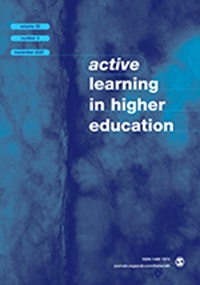积极学习的概念在从事教学变革努力的部门
IF 3.8
1区 教育学
Q1 EDUCATION & EDUCATIONAL RESEARCH
引用次数: 3
摘要
一些学术部门增加了主动学习的使用,以解决学生成功率低的问题。然而,目前尚不清楚那些实施主动学习的人是否有一个一致的概念。像其他教育术语一样,“主动学习”一词有被过度使用和误解的危险,这使主动学习的效用受到质疑。本研究考察了六所高等教育机构的115个主动学习概念,这些机构正在将更多的主动学习融入他们的数学课程。我们使用基于探究的数学教育的四大支柱作为分析这些概念的基础,并以两种方式进行比较:按利益相关者角色和按机构。我们的研究结果表明,许多参与者将主动学习概念化为学生参与和讲座以外的活动,但对教师角色和内容的关注有限。只有8位与会者提到了公平问题。个别机构内部的比较表明,部门内部的教师可能对主动学习有共同的理解。这些发现的含义包括需要发展对主动学习的理解,这种理解涉及所有四个支柱,并在部门、机构和学科之间共享。本文章由计算机程序翻译,如有差异,请以英文原文为准。
Conceptualizations of active learning in departments engaged in instructional change efforts
Several academic departments have increased their use of active learning to address low student success rates. However, it is unclear whether those implementing active learning have a consistent conceptualization of it. Like other educational terms, the phrase “active learning” is in danger of becoming overused and misunderstood, which puts the utility of active learning into question. This study examines 115 conceptualizations of active learning across six institutions of higher education that are infusing more active learning into their mathematics courses. We use the four pillars of inquiry-based mathematics education as a basis for analyzing these conceptualizations and compare them in two ways: by stakeholder role and by institution. Our findings show that many participants conceptualize active learning as student engagement and activities other than lecture, yet there was limited focus on the role of the teacher and content. Only eight participants mentioned issues of equity. Comparison within individual institutions shows that faculty within departments may hold common understandings of active learning. Implications of these findings include a need to develop an understanding of active learning that attends to all four pillars and is shared across departments, institutions, and disciplines.
求助全文
通过发布文献求助,成功后即可免费获取论文全文。
去求助
来源期刊

Active Learning in Higher Education
EDUCATION & EDUCATIONAL RESEARCH-
CiteScore
13.20
自引率
12.00%
发文量
31
期刊介绍:
Active Learning in Higher Education is an international, refereed publication for all those who teach and support learning in higher education (HE) and those who undertake or use research into effective learning, teaching and assessment in universities and colleges. The journal is devoted to publishing accounts of research covering all aspects of learning and teaching concerning adults in higher education. Non-discipline specific and non-context/country specific in nature, it comprises accounts of research across all areas of the curriculum; accounts which are relevant to faculty and others involved in learning and teaching in all disciplines, in all countries.
 求助内容:
求助内容: 应助结果提醒方式:
应助结果提醒方式:


